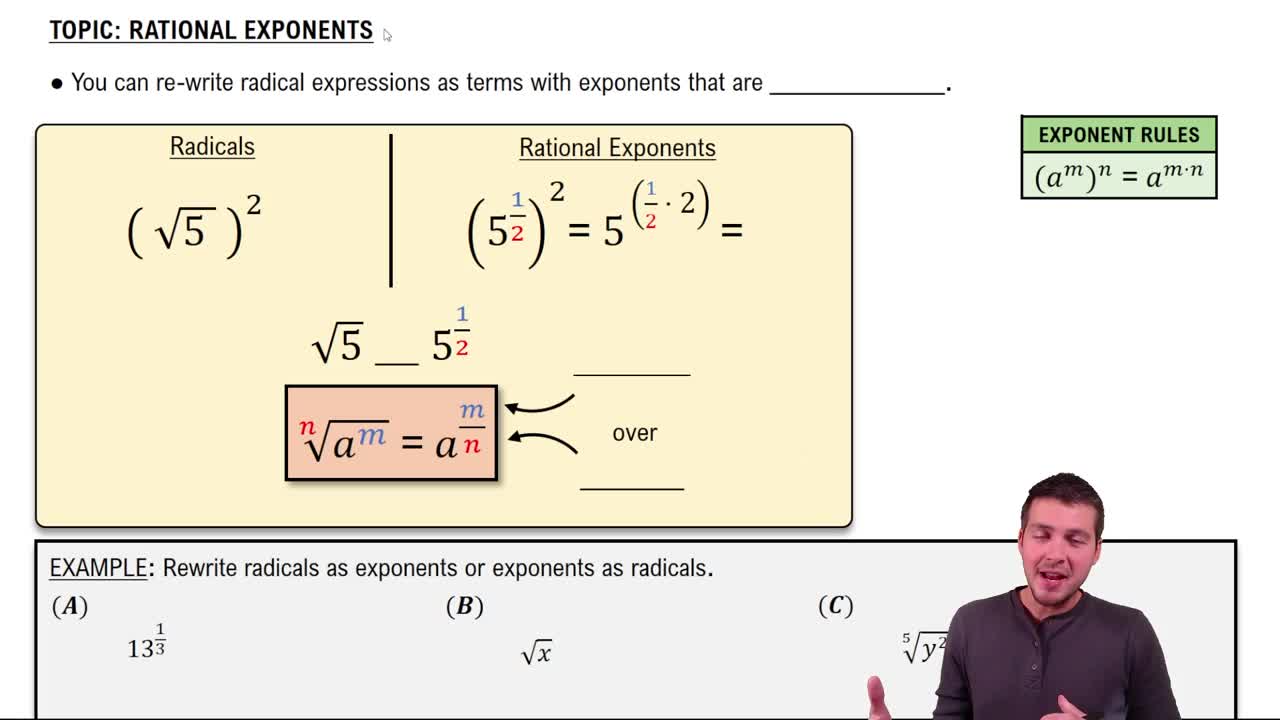Table of contents
- 0. Review of Algebra4h 16m
- 1. Equations & Inequalities3h 18m
- 2. Graphs of Equations43m
- 3. Functions2h 17m
- 4. Polynomial Functions1h 44m
- 5. Rational Functions1h 23m
- 6. Exponential & Logarithmic Functions2h 28m
- 7. Systems of Equations & Matrices4h 6m
- 8. Conic Sections2h 23m
- 9. Sequences, Series, & Induction1h 19m
- 10. Combinatorics & Probability1h 45m
0. Review of Algebra
Radical Expressions
Problem 36c
Textbook Question
In Exercises 33–38, express the function, f, in simplified form. Assume that x can be any real number. _______ f(x) = ³√48(x-2)³
 Verified step by step guidance
Verified step by step guidance1
Identify the expression inside the cube root: \(48(x-2)^3\).
Recognize that the cube root of a cube, \(\sqrt[3]{(x-2)^3}\), simplifies to \(x-2\).
Apply the property of cube roots: \(\sqrt[3]{a \cdot b} = \sqrt[3]{a} \cdot \sqrt[3]{b}\).
Simplify \(\sqrt[3]{48}\) separately, which involves finding the cube root of 48.
Combine the simplified cube root of 48 with \(x-2\) to express \(f(x)\) in its simplest form.
Recommended similar problem, with video answer:
 Verified Solution
Verified SolutionThis video solution was recommended by our tutors as helpful for the problem above
Video duration:
2mPlay a video:
Was this helpful?
Key Concepts
Here are the essential concepts you must grasp in order to answer the question correctly.
Radical Functions
Radical functions involve roots, such as square roots or cube roots. In this case, the function f(x) includes a cube root, which is represented by the notation ³√. Understanding how to manipulate and simplify expressions involving radicals is essential for solving problems related to these functions.
Recommended video:
Guided course

Expanding Radicals
Simplifying Expressions
Simplifying expressions involves reducing them to their most basic form, often by factoring or combining like terms. In the context of the given function, this means rewriting f(x) in a way that makes it easier to analyze or compute, which may involve simplifying the radical and the polynomial expression inside it.
Recommended video:
Guided course

Simplifying Algebraic Expressions
Properties of Exponents
Properties of exponents are rules that govern how to manipulate expressions involving powers. For example, when simplifying expressions with roots, one can convert the radical into an exponent (e.g., ³√a = a^(1/3)). This understanding is crucial for rewriting the function f(x) in a simplified form, especially when dealing with polynomial expressions.
Recommended video:
Guided course

Rational Exponents
Related Videos
Related Practice













